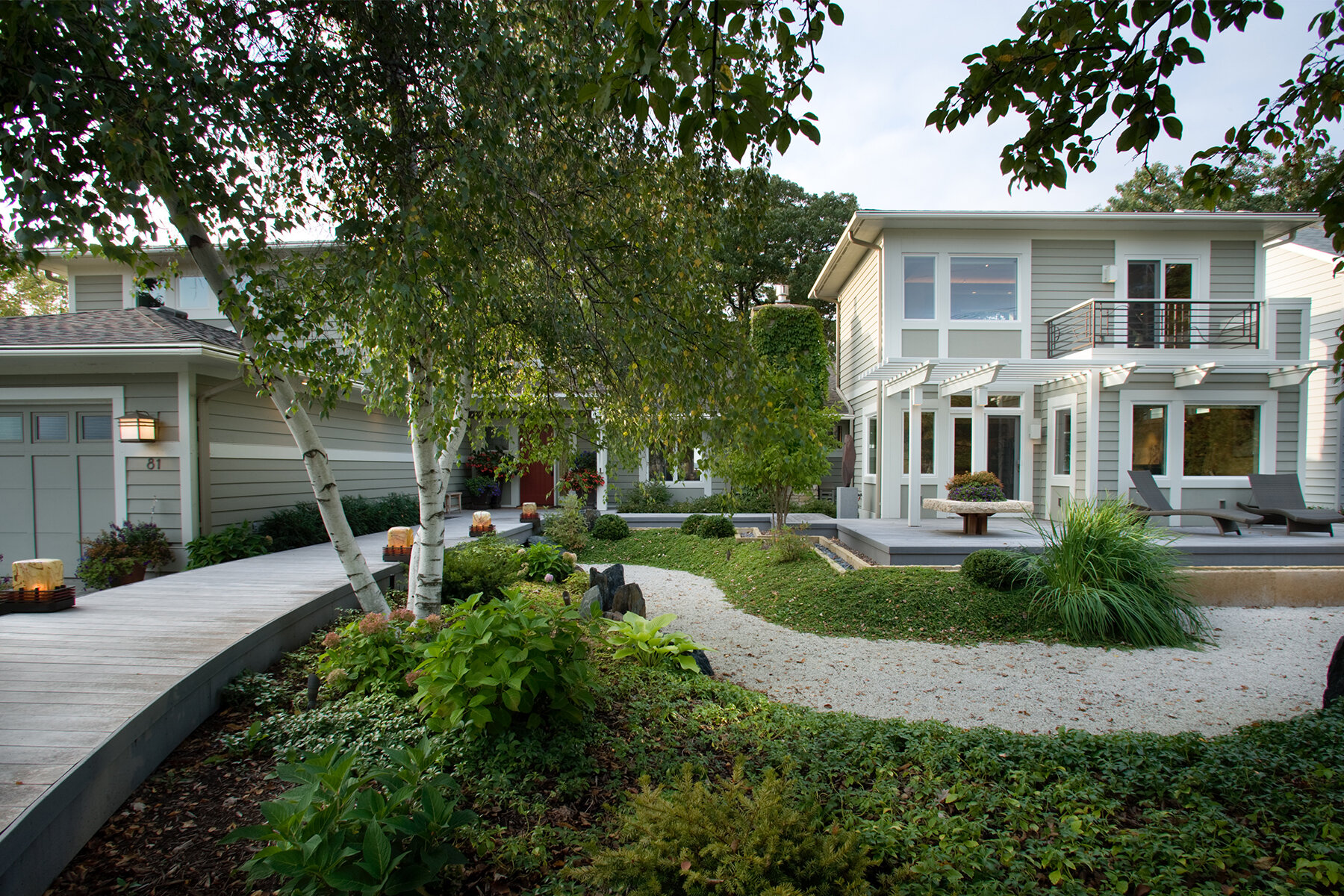Design for Aging in Place Is Simply Good Design, for All Ages
Thoughtful design can make homes safe, pleasing, and user-friendly for every stage of life
By Amy Goetzman | February 4, 2021
First image: In the remodel of this home, McMonigal Architects integrated exterior landscape and easy access for everyone at the front entry. Photo by Phillip C. Mueller. Second: A ramp integrated into a screen wall leads to a wide entry porch walkway in this home designed by Gene Nicolelli Jr. Rendering by Jeff Trish/POGO3D.
FEATURE
This year, the oldest baby boomers turn 75, and most of them want to age at home. They have invested in a house and neighborhood they love, and they have no desire to leave. Or perhaps they “podded up” with family during the pandemic and discovered they liked having grandchildren underfoot. Unfortunately, most housing stock isn’t designed well for people to age in place, either in their own homes or those of other family members. But often, modifications can be made that benefit people of all ages.
Invisible Design
“In 2005, I started reading about aging in place, and I realized that after all these years of designing homes, I’d been doing it wrong,” says Gene Nicolelli Jr., AIA, a Twin Cities residential architect and Certified Aging-in-Place Specialist. He looked at the demographics and the prevailing housing design trends and saw a big disconnect. “I wanted to design homes that people wouldn’t have to remodel or leave when they faced a health crisis or became older.” He also wanted to design homes that didn’t feel institutional. Universal design, a concept that emphasizes equity and flexibility across a diverse range of users, gave him the tools to create living spaces designed for aging in place without sacrificing aesthetic appeal.
“Universal design is a set of subtle, invisible design considerations that make a space work better for older people, people with disabilities, young children and parents—anybody can benefit from it,” says Nicolelli. “You don’t know it’s there. The house adapts to the inhabitants and their needs. Aging in place is the objective; universal design makes it possible.”
A graded walkway instead of stairs makes a home’s entry accessible for a stroller, walker, or wheelchair. A main-floor bedroom can serve as an office—until stairs become a challenge for the owners. Rollout drawers in the kitchen and handrails on both sides of a stairwell are helpful for everyone, but for people with strength and stability issues, they make all the difference. The bathroom is one of the most dangerous places in a home for unsteady or older people, and a curbless shower is a safer design choice. Add grab bars? Even better.
It’s all subtle but effective. The trick is getting people to plan ahead.
Preparing for Tomorrow Today
Younger clients are understandably resistant to including aging-in-place design features in their new build or remodel. “They don’t think they will ever need it,” says Susanne Stadler, a leading national voice on age-friendly design (another term for the concept). Or worse, they think it’s ugly. “Too much design meant to help older people lacks aesthetic appeal,” Stadler adds.
Instead of designing a home that can adapt to changing needs, people tend to make age-friendly changes only after there is a crisis, says Stadler. “In crisis mode, you don’t care about how something looks. You just want a fix,” she says. “If people were planning ahead, they would choose something that is pleasing and functional, and well designed.”
“Universal design is a set of subtle, invisible design considerations that make a space work better for older people, people with disabilities, young children and parents—anybody can benefit from it.”
She encourages architects and clients to view design for aging in place as an opportunity for creative expression. Instead of tube grab bars, for example, a driftwood bar or rock climbing holds can bring personality to a space.
“No one’s prepared for aging. People think they’re doing great,” says McMonigal Architects’ Rosemary McMonigal, FAIA. “A big part of our job is talking to our clients and getting them to think about what changes might be coming, and how to address them. Those are hard things for people to come to terms with, emotionally and psychologically.”
Thinking in terms of universal design helps clients understand that all ages can benefit from aging-in-place design features. “A 40-year-old can need a hip replacement. A person who is pregnant can get around more easily with good design,” says McMonigal. “Spaces can be more usable and safer for everyone.”
Adapting older homes can be a challenge, however, and sometimes she advises clients that moving makes the most sense. “We do a lot of feasibility studies,” says McMonigal. “Does it make sense to do work on this house? For the length of time you plan to live here? Sometimes you do that study and come to the conclusion that it’s better to move.”
Challenges posed by older housing stock include many steps up to the house, narrow door openings, and rooms with level changes. “You don’t see many of them now, but even Frank Lloyd Wright did some sunken living rooms, and we know now that they pose a tripping risk and mobility barrier,” says McMonigal. “These types of features require substantial remodels. But there are many other things that require very little effort to change. Sometimes the small things can allow people to live in their home quite a bit longer.”


